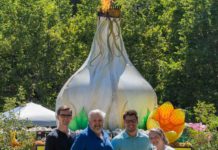Three Gilroy students nabbed awards at a state science
competition that featured nearly 1,000 winners of county science
fairs.
Gilroy – Three Gilroy students nabbed awards at a state science competition that featured nearly 1,000 winners of county science fairs.
Solorsano Middle School students Collin Gavin, Kevin Lee and Spencer McManus earned honorable mentions at the California State Science Fair last week. The young scientists received medallions for their achievement at the California Science Center in Los Angeles, where the competition was held.
An honorable mention at this fair is no small feat, said Dawn O’Connor, their science teacher and advisor.
“The range of projects are amazing when you get to the state level,” she said.
The three students qualified for the state competition by winning a countywide fair, the Synopsys Silicon Valley Science and Technology Championship, in early March. There, Gavin took home numerous awards for his first-place experiment in pharmacology, “The Effect of Nanoscale Particles on Mammalian Cell Viability.” Lee and McManus teamed up to score top honors for a physics project, “Which Type of Wind Turbine is More Efficient and Useful?”
While they presented the same projects at the state competition, the judges and the scoring criteria were different, students said.
The judges were “more focused on the scientific aspects of the project” than how the student came up with the idea, Gavin said.
In addition, while county judges provided feedback and allowed students to incorporate responses in future presentations to other judges, this was not permitted at the state level.
“It’s the knowledge you came in with,” McManus said.
Solorsano student Meghan Carvalho also presented at the state competition in the field of zoology, but had her efforts derailed by the presence of a similar project from another student. According to fair rules, similar projects cannot score originality points.
Finding a similar experiment was surprising to Cavalho, who studied the heredity of fruit flies for months and produced a project titled, “Will the Autosomal Recessive Mutation of Vestigial Wings Appear in the F1 Generation?”
However, she was not upset by not placing, as she believed the competition to be a learning experience. In particular, she was excited by experiments submitted by high school students also presenting at the competition.
“I looked at the zoology from the seniors and I saw some cool projects,” she said.













